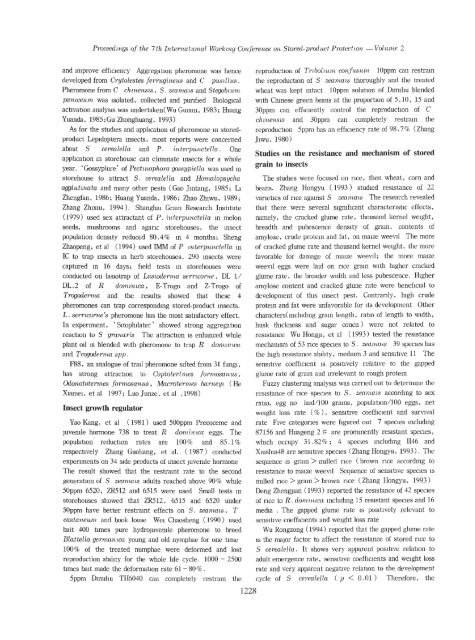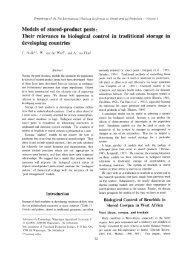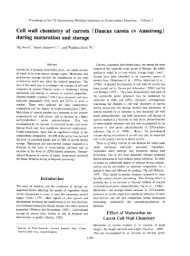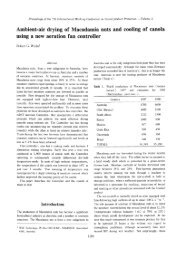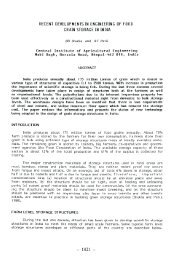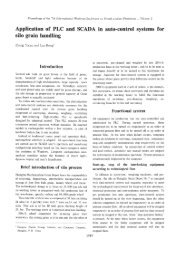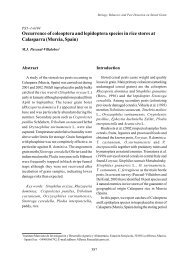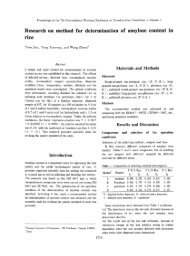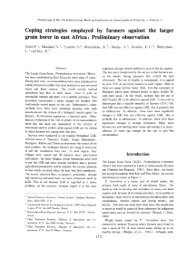Evolution of biological control of stored-product pests - SPIRU Index ...
Evolution of biological control of stored-product pests - SPIRU Index ...
Evolution of biological control of stored-product pests - SPIRU Index ...
You also want an ePaper? Increase the reach of your titles
YUMPU automatically turns print PDFs into web optimized ePapers that Google loves.
Proceedmqs <strong>of</strong> the 7th Iniernatumal Worhng Conference on Stored-<strong>product</strong> Protection - Voz'nme 2<br />
and Improve efficiency Aggregation pheromone was hence<br />
developed from Crytolestes [erruqineus and C pusillus .<br />
Pheromone from C ch.mensis , S. zeanuus and Steqoaucm<br />
ixuuceum was Isolated, collected and purified Biologtcal<br />
actrvation analysis was undertakent Wu Guixm, 1983; Huang<br />
Yuanda, 1985;Gu Zhonghuang, 1993)<br />
As for the studies and application <strong>of</strong> pheromone m <strong>stored</strong><strong>product</strong><br />
Lepidoptera insects, most reports were concerned<br />
about S cerealella and P. inierpunctella.. One<br />
apphcauon m storehouse can ehmrnate msects for a whole<br />
year. "Gossyplure ' <strong>of</strong> Pectmophora gossypieUa was used in<br />
storehouse to attract S. cerealella and Homalopsycha<br />
aggluttnata and many other <strong>pests</strong> (Gao Jmtang , 1985; LI<br />
Zhengfan, 1986; Huang Yuanda, 1986; Zhao ZhlWU, 1989;<br />
Zhang ZhIXlU, 1994). Shanghai Gram Research Institute<br />
(1979) used sex attractant <strong>of</strong> P. interpunciella m melon<br />
seeds, mushrooms and aganc storehouses, the msect<br />
population density reduced 80.4% m 4 months; Sheng<br />
Zhaopeng, et al (1994) used IMM <strong>of</strong> P mterpuncteila in<br />
IC to trap msects m herb storehouses, 290 insects were<br />
captured in 16 days; field tests in storehouses were<br />
conducted on lasiotrap <strong>of</strong> Losuxlerma serricorne , DL 1/<br />
DL. 2 <strong>of</strong> R domuuca , E- Trogo and Z-Trogo <strong>of</strong><br />
Troqoderma and the results showed that these 4<br />
pheromones can trap correspondmg <strong>stored</strong>-<strong>product</strong> insects.<br />
L. eerncorne's pheromone has the most satIsfactory effect.<br />
In expenment, 'SItoplulater' showed strong aggregatIon<br />
reactIon to S granaris The attractIon IS enhanced whIle<br />
plant 011 IS blended wIth pheromone to trap R domullca<br />
and Trogoderma spp.<br />
F88, an analogue <strong>of</strong> trail pheromone SIfted from 31 fungI,<br />
has strong attractIOn to Coptotertmes fonnosanus,<br />
Odonototermes formosanus, Macrotermes barneyl (He<br />
XiameI, et al 1997; Luo J unze, et al ,1998)<br />
Insect growth regulator<br />
Yao Kang, et al (1981) used 500ppm Precoceme and<br />
Juvemle hormone 738 to treat R domimca eggs. The<br />
populatIon reductIon rates are 100% and 85.1 %<br />
respectIvely Zhang Guohang, et al. (1987) conducted<br />
expenments on 34 SIde <strong>product</strong>s <strong>of</strong> msect Juvemle hormone<br />
The result showed that the restramt rate to the second<br />
generatIon <strong>of</strong> S zeanwu; adults reached above 90% whIle<br />
50ppm 6520, ZR512 and 6515 were used Small tests m<br />
storehouses showed that ZR512 , 6515 and 6520 under<br />
50ppm have better restramt effects on S. zeamalS, T<br />
castaneum and book louse WeI Chaosheng (1990) used<br />
bai t 400 tImes pure hydroJuvemle pheromone to breed<br />
Blattella germamca young and old nymphae for one tIme<br />
100% <strong>of</strong> the treated numphae were deformed and lost<br />
re<strong>product</strong>ion abilIty for the whole life cycle. 1000 - 2500<br />
tImes baIt made the deformatIOn rate 61- 80%.<br />
5ppm DimIllU TH6040 can completely restram the<br />
1228<br />
re<strong>product</strong>ion <strong>of</strong> Tribolium confusum lOppm can restram<br />
the re<strong>product</strong>ion <strong>of</strong> S zeanuus thoroughly and the treated<br />
wheat was kept intact 10ppm solution <strong>of</strong> Dmuhu blended<br />
with Chinese green beans at the proportion <strong>of</strong> 5,10, 15 and<br />
30ppm can efficiently <strong>control</strong> the re<strong>product</strong>ion <strong>of</strong> C<br />
chineneis and 30ppm can completely restram the<br />
re<strong>product</strong>ion<br />
JIWU, 1980)<br />
5ppm has an efficiency rate <strong>of</strong> 98.7% (Zhang<br />
Studies on the resistance and mechanism <strong>of</strong> <strong>stored</strong><br />
grain to insects<br />
The studies were focused on nee, then wheat, corn and<br />
beans. Zhang Hongyu (1993) studied resistance <strong>of</strong> 22<br />
vane ties <strong>of</strong> nce against S zeanw,'LS The research revealed<br />
that there were several significant charactensnc effects,<br />
namely, the cracked glume rate, thousand kernel weight,<br />
breadth and pubescence density <strong>of</strong> gram, contents <strong>of</strong><br />
amylose, crude protem and fat, on maize weevil The more<br />
<strong>of</strong> cracked glume rate and thousand kernel weight, the more<br />
favorable for damage <strong>of</strong> maize weevil; the more maize<br />
weevil eggs were laid on nee gram With higher cracked<br />
glume rate, the broader WIdth and less pubescence. HIgher<br />
amylose content and cracked glune rate were beneficial to<br />
development <strong>of</strong> tlus insect pest. Contranly, high crude<br />
protem and fat were unfavorable for ItS development Other<br />
characters(mcludmg gram length, ratIO <strong>of</strong> length to WIdth,<br />
husk thIckness and sugar concn) were not related to<br />
reSIstance Wu HOngjI, et al (1993) tested the reSIstance<br />
mechamsm <strong>of</strong> 53 nce speCIes to S. zeamms 39 speCIes has<br />
the hIgh reSIstance ablhty, medlUm 3 and senSItIve 11 The<br />
senSItIve coeffICIent IS pOSItIvely relatIve to the gapped<br />
glume rate <strong>of</strong> gram and Irrelevant to rough protem<br />
Fuzzy clustenng analYSIS was carned out to determme the<br />
reSIstance <strong>of</strong> nce speCIes to S. zea mms accordmg to sex<br />
ratIO, egg no laId/1 00 grams, populatIOn/lOO eggs, net<br />
weIght loss rate (%), senSItIve coeffICIent and surVIval<br />
rate FIve categones were fIgured out 7 speCIes mcludmg<br />
87156 and Huageng 2 # are prommently reSIstant speCIes,<br />
whIch occupy 31.82%; 4 speCIes mcludmg II46 and<br />
XlUshUl48 are senSItIve speCIes (Zhang Hongyu, 1993). The<br />
sequence IS gram> milled nce (brown nce accordmg to<br />
reSIstance to maize weeVil Sequence <strong>of</strong> senSItIve speCIes IS<br />
mIlled nce> gram> brown nce (Zhang Hongyu, 1993)<br />
Deng Zhengjlan (1993) reported the reSIstance <strong>of</strong> 42 speCIes<br />
<strong>of</strong> nce to R. donwuC(1, mcludmg 15 reSIstant speCIes and 16<br />
medIa . The gapped glume rate IS pOSItIvely relevant to<br />
senSItIve coeffICIents and weIght loss rate<br />
Wu Rongzong (1994) reported that the gapped glume rate<br />
IS the major factor to affect the reSIstance <strong>of</strong> <strong>stored</strong> nce to<br />
S cerealella. It shows very apparent poSItIve relatIOn to<br />
adult emergence rate, senSItIve coeffICIents and weIght loss<br />
rate and very apparent negatIve relatIOn to the development<br />
cycle <strong>of</strong> S ceJ'ealella (p < 0.01) Therefore, the


